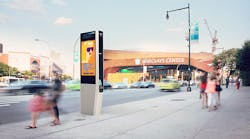As part of an effort to bring municipal Wi-Fi to the millions of people traveling through and living in New York City, the LinkNYC network aims to transform outdated payphones into state-of-the-art wireless connection points. The network, which will span across all five boroughs, will provide free 24/7 Internet access at speeds up to 1 Gbit/s, free phone calls to anywhere in the U.S., easy access to 911 and 211, and a free charging station for mobile devices. It’s expected the stations will generate more than $500 million in revenue for the city over the next 12 years.
The encrypted network connection will be implemented by the CityBridge team behind LinkNYC, a consortium of members including Comark, Control Group, Qualcomm, and Titan. The stations will feature an Android touchscreen interface to access city services and directions alongside digital displays for advertising and public service announcements. Up to 10,000 Link stations will be installed (beginning in 2015 with operation expected by the end of the year), delivering Wi-Fi speeds that are 100 times faster than conventional municipal Wi-Fi.
The amount of installed Link stations will also create a seamless roaming experience, thanks to the Wi-Fi signals within the city’s subway stations provided by Transit Wireless (it will also integrate the high-speed fiber infrastructure to power the new stations). The signals, however, will only work within 150 ft. of each 9.5 ft. tall hub. The company’s fiber-optic cables currently run through ducts under the city streets to the subway stations to connect the multi-band RF nodes within each station to distribute the signals.
Transit Wireless’ Wi-Fi network runs parallel to the cellular distributed antenna system (DAS), providing a fiber-to-edge network that aims to maximize throughput and performance. Access points deliver 2.4- and 5-GHz public unlicensed band, and 4.9-GHz public safety band, connectivity throughout locations in each station. Similar technology will be used to provide the network for the Link stations.
According to CNET’s Ben Fox Rubin in “In NYC, once a payphone, soon a superfast Wi-Fi hub”:
LinkNYC comes despite a mixed history of municipal Wi-Fi projects, with cities including New York, Philadelphia and dozens others throughout the US trying–and failing–to create and sustain such services. Cities have claimed these kinds of projects can help spur economic activity and narrow the digital divide between those who can access the Internet and those who can't. Yet many of these projects were scraped [sic] or scaled back over the years after cities and developers butt up against financial, competitive and technical challenges. Several current municipal Wi-Fi networks are available only in downtown areas and for a few hours a day for users.
The CityBridge team has already piloted a few Wi-Fi payphone hotspots over the past two years, though, and city residents won’t have to pay any tax dollars toward construction of the new network. The contracted expenses, in combination with the prime advertising space and subsequent revenue, are expected to push the project onto a successful and maintainable level.
